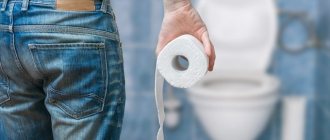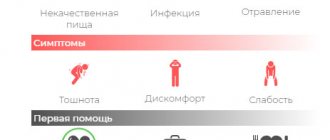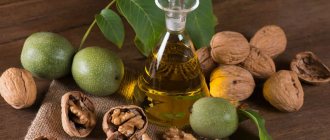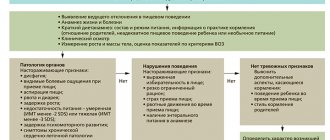When a newborn appears in the family, young parents immediately have many questions. One of the most popular and discussed topics at parenting conferences on the Internet is baby stool. New mothers are concerned about whether their baby’s bowel movements are normal, whether he has diarrhea (diarrhea) or, conversely, constipation, and whether it is necessary to take a stool test for dysbacteriosis?
Normal stool in children from 0 to one year is a relative concept. Firstly, its frequency and nature depend on the type of feeding (breastfeeding or bottle-feeding) and the availability of complementary foods. Secondly, as the child ages, the “norms” of stool change.
However, there are symptoms that are highly likely to indicate trouble in the baby’s body - if they appear, you should definitely consult a doctor :
- when breastfeeding, stool more than 7 times a day, and when feeding with formula - more than 4-5 times
- stool less than 1-2 times a day
- feces have a specific unpleasant odor or an admixture of mucus, greenery, blood
- watery or greasy stools
- When defecating, the child cries and kicks his legs
Diseases and risk factors
Constipation in children can be caused by a number of diseases that directly or indirectly affect the digestive process.
Hirschsprung's disease
This disease is characterized by a congenital defect in the nerve endings of the colon. These nerve endings are necessary to regulate the contractile function of the intestines, due to which feces are transported. Due to the lack of nerve endings, the intestinal walls do not contract, thereby causing stagnation and accumulation of contents.
Celiac disease
Celiac disease, or celiac disease, is a chronic digestive and immune disorder that damages the small intestine. The disease occurs due to eating foods containing gluten. Gluten is a protein found primarily in flour products such as pasta, cookies, and bread.
This disease occurs due to genetic characteristics of a person, which lead to the inability of the intestines to absorb gluten and disrupt the process of formation of feces.
Spina bifida
A congenital spinal malformation, a type of neural tube defect, often combined with defects in the development of the spinal cord. The defect is an incomplete closure of the neural tube in an incompletely formed spinal cord, which leads to paralysis of the lower extremities, bowel and bladder dysfunction.
Hypothyroidism
Hypothyroidism or underactive thyroid gland. The thyroid gland is an organ that produces a large number of hormones that control the functioning of the body. If the gland does not produce enough hormones, a person experiences a number of symptoms, which include constipation.
Constipation can also be caused by other diseases that affect the digestion process in one way or another. These include various tumors pressing on the intestines, injuries to the brain and spinal cord, and diabetes.
A number of medications can also cause indigestion:
- Anticonvulsants;
- Preparations containing aluminum and calcium - antacids;
- A number of painkillers;
- Some antidepressants;
- Antispasmodics.
Signs of the disease
Source: t.tomsickova / Depositphotos
Clinical manifestations of constipation are varied. They become most pronounced with prolonged constipation and are:
- Bowel movements less than 2 times a week;
- The stool comes out heavily, its substance is dry, hard, consisting of many pieces;
- Defecation is accompanied by pain;
- The child may feel that some of the contents have not come out;
- Abdominal pain and bloating;
- Traces of liquid stool on underwear.
You should immediately seek medical help if you have the following symptoms:
- Bleeding from the anus;
- Blood in the stool;
- Weight loss;
- Vomit.
If older children can talk about a problem with the intestines, then parents may not even be aware of the problem of a very young child.
Important: symptoms of constipation in an infant:
- Problems with sleep, the child often wakes up and cries.
- When changing the diaper and washing the baby, he behaves restlessly, fidgets, and begins to cry. This is associated with pain during bowel movements.
- The baby poops less frequently than usual and his or her stools are hard or pellet-like.
Chronic constipation is characterized by skin changes. It becomes pale, acquires an earthy tint, and loses elasticity. Becomes dry and flaky. There is a coated tongue and bad breath.
When to contact a pediatrician?
Newborns and older babies report problems with bowel movements using certain symptoms. Caring parents will definitely notice the following deviations:
- vomiting;
- lack of gas;
- poor sleep and appetite;
- increased nervousness;
- anxiety during feeding;
- twisting legs due to bloating and pain in the tummy (possibly hard).
Fecal masses in the presence of these anomalies are characterized by increased density. The color of feces changes from yellow to dark if the baby is switched to formula. The reason for contacting a doctor is both the strange consistency and shade of stool, and the general condition of the child with problems with stool and passing gas.
For example, if a baby does not poop and has difficulty passing gas, this condition poses a danger to the body. The combination of symptoms indicates intestinal obstruction. If the baby farts but does not poop, he is not in danger of obstruction. Moderate gas formation against the background of rare bowel movements indicates normal functioning of the gastrointestinal tract.
Mother's diet
Source: Alexander Dummer: Pexels
Breastfeeding mothers often wonder how their diet affects the quality of their breast milk and how choosing foods for it can affect the baby's digestive system. However, most women do not need to restrict their diet while breastfeeding and should aim for a nutritious and varied diet.
In some cases, infants may seem to avoid feeding after the mother has taken certain foods. In this case, a woman can simply eliminate this food from her diet and return to it after stopping breastfeeding.
Important: Special recommendations include avoiding caffeine while breastfeeding. Caffeine is easily transmitted to the baby through milk. It reduces the amount of iron in milk, which can lead to iron deficiency anemia. It is recommended that a nursing mother consume no more than 400 milligrams of caffeine per day. The most caffeine is found in coffee and chocolate, and the least in tea.
A healthy diet while breastfeeding is essentially the same as a nutritious diet without breastfeeding. The main difference is that breastfeeding people need 450 to 500 extra calories per day. But if you want to lose weight after pregnancy, you can do without them, having first discussed this with your doctor.
A healthy diet for a pregnant woman includes:
- Fruits, especially rich in potassium and vitamin A (melon, banana, apricot, mango, oranges). Helps reduce the risk of constipation in both the child and the mother;
- Vegetables containing vitamin A and potassium (spinach, carrots, tomatoes, red peppers);
- Grain products, especially brown rice and whole grain bread;
- Protein-containing foods such as beans, peas, nuts, meat, fish, mussels.
Important: A nursing mother needs to drink a lot of water, especially in the first weeks after birth. Lack of fluid negatively affects milk production. A sufficient amount of water ensures the efficient functioning of the digestive system, helps food to be absorbed, which means breast milk will be well-balanced in nutrients. The higher the conditional quality of milk, the lower the likelihood of constipation in a child, since balanced milk improves peristalsis and fecal removal.
Age norms
A breastfed newborn baby can have bowel movements as many times as he is fed. If a child has stool 1-2 times a day or less during the first 3 months of life, you should consult a doctor. For bottle-fed children under one year of age, constipation is considered to be the absence of independent bowel movements during the day.
A common cause of constipation in breastfed infants is disturbances in feeding and nutrient absorption.
If there is quantitative underfeeding or good absorption of the mother's breast milk, the volume of feces in the child is not sufficient to arouse the urge to defecate. In such cases, retention of stool for 2-3 days is not considered true constipation.
Important: Constipation in infants who are breastfed and complementary foods is caused by a lack of foods containing plant fiber. Excess fat in food aggravates constipation and promotes even greater hardening of stool.
In addition to reducing the frequency of bowel movements with constipation, children may experience a decrease in appetite and abdominal pain. With chronic constipation, the volume of stool increases.
Intestinal infections
Intestinal infections are quite common in infants. Even the most careful and clean parents cannot always avoid the development of an intestinal infection in their baby. The fact is that the protective functions of the intestines (acidity of gastric juice, local immune factors) in infants are not yet fully formed, and some pathogens that are not dangerous for adults can cause serious disorders in an infant.
As a rule, the infection begins suddenly - with abdominal pain (the child cries, kicks his legs) and diarrhea (sometimes with inclusions of mucus, greens, blood and other impurities). Intestinal infections may be accompanied by a rise in temperature, but this does not always happen. If any of the described symptoms appear, be sure to call a doctor, and before he arrives, try to alleviate the child’s condition with the following measures:
- With loose stools, the child loses a lot of water and salts, and he may become dehydrated. To prevent this from happening, the baby must be given one of the saline solutions - for example, Oralite, Rehydron. The drug enterodez, in addition to salts, also contains activated carbon, which adsorbs toxins from the intestines. One of these drugs should be kept in your home medicine cabinet at all times. It is very important to completely replace the child with the volume of fluid that he loses through stool and vomiting (it is advisable to measure this volume). If the baby does not drink from a bottle, liquid can be given from a spoon or even from a pipette - small portions of liquid do not provoke vomiting as much as large ones. It is not advisable to give your child regular boiled water, since a lot of salts are lost with intestinal contents - if you give liquid without salts, this deficiency will worsen.
- In addition to fluid replenishment solutions, the child can be given adsorbents (smecta, polyphepan, enterosgel) - drugs that, like a sponge, absorb toxins contained in the intestines. But keep in mind that while these drugs absorb toxins, they do not destroy pathogenic bacteria. In large quantities they can lead to constipation.
- Should I feed my child in the midst of an intestinal infection? Yes, feed. But the amount of food per day should be reduced by 1/3-2/3 compared to normal (depending on the maximum amount of food that does not lead to vomiting). If the child is breastfed, then continue to feed him breast milk; in such situations, it is better to give artificial milk formulas to artificial babies. Feed more often, but in small portions. You can add 1/4 tablet of the enzyme preparation Mezim-Forte to each feeding. Here, perhaps, are all the measures that can be taken before the doctor arrives.
- Never give an infant antibiotics without a doctor's prescription: some of the antibiotics often used for intestinal infections in adults are contraindicated in newborns (for example, chloramphenicol). Great care should be taken when using drugs such as Imodium and other symptomatic drugs in infancy - be sure to consult your doctor.
How to protect a child from intestinal infections?
- First of all, you should pay attention to the dishes from which you feed your baby. It should be dry. Some mothers boil bottles for a long time, but then leave some of the moisture in them. Moisture promotes the growth of bacteria.
- Secondly, you should not often pour food from one dish to another - the less often you do this, the better. That is why modern breast pumps are immediately connected to a feeding bottle.
- Finally, avoid licking pacifiers, spoons, and other baby utensils. The germs in your mouth are not always safe for your baby (for example, Helicobacter, which causes peptic ulcers, or germs that cause tooth decay). Pathogenic bacteria are transmitted mainly from person to person, so it is better to simply rinse a pacifier that has fallen on the floor with water (at worst, not even wash it at all) than to lick it.
Causes and types
Source: freepik - ru.freepik.com
Constipation in a child can be one of the manifestations of diseases not directly related to the pathology of the gastrointestinal tract (such as rickets, hypothyroidism). However, in the vast majority of cases, constipation is caused by problems with the intestines themselves.
During digestion, the intestinal walls contract in waves, pushing the contents towards the outlet - this phenomenon is called peristalsis or intestinal motility. There are two main options for intestinal motility disorders:
If the child’s stool is very rare, accompanied by bloating, and the volume of feces during bowel movements is large (as in an adult), we can assume that this is the so-called atonic constipation. Constipation associated with insufficient contractile activity of the intestines is called atonic. In this case, the child may not have the urge to defecate for a long time.
Compulsory measures (long-term potty training) usually only aggravate the situation and reinforce the child’s negative attitude towards what is happening.
Thick stools consisting of hard, smooth pellets (the so-called “sheep feces”), abdominal pain, and sometimes pain during defecation usually indicate spastic constipation. Spastic constipation in children occurs due to spasms (increased contractile activity) of the intestines.
In some cases, stool is released in the form of a ribbon or a thin stream. In such a situation, the child should be consulted with a surgeon to exclude organic pathology of the rectum (narrowing, neoplasm).
Lactase deficiency due to allergic inflammation in the intestines
In cases where a child begins to receive foreign protein too early (most often these are cow's milk or soy proteins contained in formula feeding), allergic inflammation often develops in the intestines. As a result, lactase production is disrupted.
Allergic inflammation in the intestines is not always accompanied by changes in the skin, and outwardly the child may not have any signs of allergy. In addition to impaired digestion of lactose, these children have impaired absorption of many other substances in the intestine. Therefore, it is recommended to conduct an allergy examination in a bottle-fed child with prolonged diarrhea.
Treatment of constipation in children
Should I get an enema for constipation? It is not worth resorting to enemas often, since this suppresses the natural urge to defecate and disrupts the normal formation of the reflex. However, occasionally for constipation in children, you can use this remedy, following all the necessary recommendations. You can learn how to properly give an enema to a child from this video:
The volume of an enema for constipation in a newborn child up to 1 month is 30 ml, for a child 1-3 months - 30-40 ml (the smallest enema, not completely filled), for a child 3-6 months - 90 ml, 6-12 months - 120-180 ml. It is important to remember that the water in the enema should not be warm, but at room temperature (22-24 degrees). Toxic substances accumulated in the intestines quickly dissolve in warm water and are subsequently easily absorbed into the bloodstream.
If it seems that the intestines have not been completely cleansed, you should not rush: usually after the first portion, provoked by an enema, there is independent stool. Large-volume enemas should be performed by a doctor, as serious complications can occur.
What to do if your child is constipated?
- For any constipation in children, it is important that the child receives enough fluid - with water or clear, low-fat broth.
- For atonic constipation, massage of the anterior abdominal wall in a clockwise direction, laying on the stomach, and mild tactile irritation of the anus helps well.
- For spastic constipation, it is possible to use baby suppositories with glycerin. You should not introduce any foreign substances (soap, baby oil, etc.) into the rectum.
Treatment of constipation (especially chronic) in children is impossible without adherence to the regimen. It is advisable to teach your child to go and poop at the same time every day. To stimulate bowel movements, you can give your child a drink of cold water or fruit (for example, apple) juice in an age-appropriate dose. These activities must be carried out at the same time every day.
Lactase deficiency
If your child has frequent, watery, foamy stools with a sour odor, he or she may be lactose intolerant. Lactose is milk sugar, making up about 99% of all carbohydrates in any milk, including human milk. A special enzyme, lactase, is responsible for the breakdown of lactose. If for some reason the activity of this enzyme is reduced (so-called lactase deficiency ), excess undigested lactose leads to diarrhea.
The simplest and most accessible test for suspected lactose intolerance is to determine the amount of carbohydrates in the stool.
For proper treatment, it is necessary to find out the cause of intolerance, be sure to consult with a pediatric gastroenterologist and, possibly, an allergist. If a child has received breast milk, he is not deprived of this beneficial product. As a rule, it is recommended to express about 1/4-1/3 of the volume of one feeding and add lactase ( an enzyme that breaks down lactose) to the expressed milk. At the beginning of feeding, the baby should be given expressed milk with lactase , and then supplemented from the breast. The dosage of the enzyme is selected by the doctor individually.
If the child is on artificial or mixed feeding, then the adapted milk formula is either replaced with a low-lactose or lactose-free formula (it is also better to consult a doctor about the selection of a medicinal formula), or a lactase is added to the regular milk formula and incubated for some time before feeding.
As children grow older, the activity of the lactase increases and the symptoms of lactose intolerance completely disappear.
Traditional methods of treatment
In addition to standard treatments, there are alternative ways to combat constipation.
Abdominal massage
In addition to relieving symptoms and treating constipation, abdominal massage has a strengthening effect on the abdominal muscles and relieves pain from infant colic.
Source: oksun70 / Depositphotos
The essence of the massage is light and gentle stroking of the child’s abdomen, smoothly transitioning to pinpoint pressure with the pad of the index finger from the navel to the periphery. The massage also ends with a smooth transition to stroking. The procedure is performed an hour before and after meals.
Treatment with medicinal plants
Many plants have a laxative effect and can be used as an auxiliary element in complex treatment. These plants include:
- anise;
- zhoster laxative;
- dandelion officinalis;
- horse sorrel;
- big plantain.
Plants are taken in the form of decoctions, infusions and teas. It is recommended to take breaks between courses of treatment for 2-3 weeks. This is necessary to avoid getting used to the fees and reducing their effectiveness.
It is not recommended to use medicinal laxatives without a doctor’s prescription: they can lead to increased gas formation and cause discomfort in the child.
Acupuncture
Acupuncture is an element of traditional Chinese medicine. The essence of the method is to insert thin needles into different parts of the body. To treat constipation, needles are inserted into the area of the large intestine. This procedure helps to relax the intestinal walls and facilitate bowel movements.
Insufficient knowledge of the effectiveness of acupuncture prevents it from becoming a standard method in the treatment of constipation. The method may be accompanied by pain and bleeding.
Important: Acupuncture should only be performed by a qualified professional. And it is worth remembering that any trend from alternative medicine cannot replace real, evidence-based treatment.










